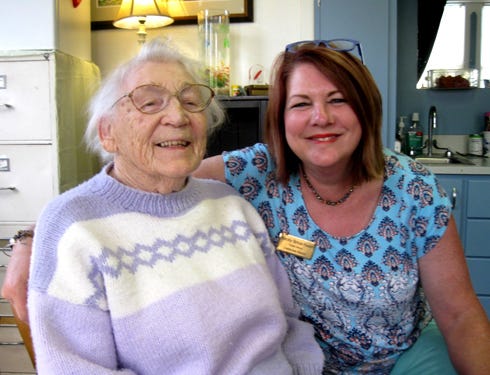
CRESTVIEW — Once Molly Cleek starts chatting about her five years in the British Army’s Auxiliary Territorial Service, the memories come flooding back.
“I was born in a pub — the White Lion — in a village called Blagdon Hill in Somerset,” the 94-year-old Crestview Manor resident said. “My grandfather ran the pub.”
Serving her king and country was an exciting opportunity, so Cleek left home to serve at a rural anti-aircraft battery outside London.
Life was different from the warm, cozy pub in which she grew up.
“There were four of us on the radar,” she said. “We had to get up every four hours to start the generator. We’d sleep in an old barn in the middle of a field. We didn’t get much sleep because the horses would keep kicking the barn.
“It was so cold, that place. They’d bring us a bucket of cocoa at night. It was the most awful, bitter stuff because there was no sugar to be had. But we drank it because it was hot.”
Two years later, Cleek transferred to a stenographer’s post at Gen. Dwight D. Eisenhower’s London headquarters. As the D-Day invasion approached, “There was plenty of excitement there,” she said.
By that late stage of the war, the Blitzkrieg was over. Instead, Londoners “kept calm and carried on” under occasional V1 and V2 missile attacks.
“A few rockets came over, but it wasn’t too bad then,” Cleek said. “The sirens would go off and you’d go down in the basement.”
After the war, she accepted a secretarial position with an American firm in Germany, where she met and married Everett “Red” Cleet, an American soldier from Indiana.
After a couple of years in Norway, the couple moved to Red’s home state and had three children: Colin, a retired Air Force master sergeant who lives in Crestview; Warren; and Nora.
Crestview Manor Director Becky Brice-Nash, a fellow veteran, finds Molly inspirational.
“My 24 years in the Air Force were formed by women like you,” she told Cleek.
“You paved the way for women to be the professionals they are today.”
The Auxiliary Territorial Service, the British Army’s World War II women's branch, formed as a voluntary service on Sept. 9, 1938 and merged into the Women's Royal Army Corps on Feb. 1, 1949.
Due to shortages of men, ATS and other women's voluntary service members tackled support tasks, working as radar operators, anti-aircraft gun crews and military police.
Source: Imperial War Museum, London
FYI


This article originally appeared on Crestview News Bulletin: Crestview Manor resident recalls serving during World War II
